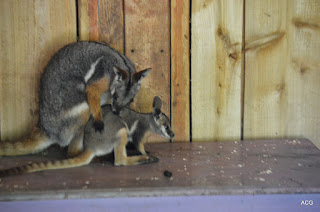Recently gone on show in the new Wallaby Walkthrough exhibit
is a family of Yellow-Footed Rock Wallabies, Petrogale xanthopus. Originating
from Queensland and the Flinders Ranges in South Australia, it is one of perhaps
17 species of rock wallaby which collectively are found all across Australia.
Petrogale species are medium-sized relatives of kangaroos,
standing up to 60cm tall and a maximum weight of around 13kg. They are in
effect the ecological equivalent of mountain goats, being highly agile
inhabitants of rocky areas. They are mostly nocturnal or crepuscular, hiding
away in caves during the day and emerging at night to feed on grasses and
herbs, when they may descend to lower ground to feed. As a result of this
habit, and the agility with which they can escape from predators such as foxes
and dingoes, they are less threatened than many Australian mammals. Only one of
the species are listed as Endangered, with several more listed as Near
Threatened, including the species Bristol has on show. Main threats are
competition with domestic livestock, overgrazing, and changes in fire regimes.
 |
| Female with large joey in pouch |
Rock wallabies can often be sociable, and Yellow-Footed Rock
wallabies are commonly found in groups of 20 or so individuals, exceptionally
as many as 100. Populations fluctuate with rainfall, and control of goats and
foxes especially are beneficial to the populations.
 |
| Joey with mother |
The animals on show at Bristol arrived as a male plus 2 females
from continental zoos. Not long after they went on show, one of the females was
seen to have young in the pouch, which was unexpected as the mother would not
have been sent over if she was known to be carrying a youngster. The joey has
now left the pouch and is “at foot” as it is called when a youngster is still
reliant on the mother but no longer being carried. Hopefully this is a good
omen for the breeding of rock wallabies at Bristol. Although they tend to stay
in their inside quarters during the day, they can be seen through the glass.
Usually they just sit quietly (except for the joey). The best time to see them
outside is late in the day just before the zoo shuts.
(images are mine)

No comments:
Post a Comment